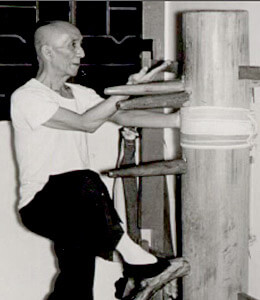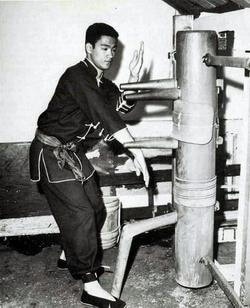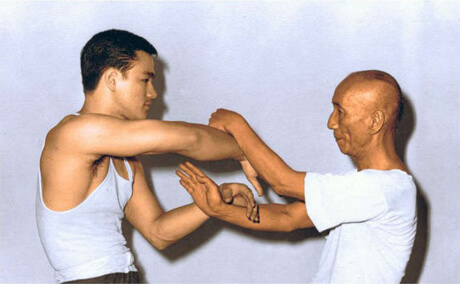Let’s Improve Your Wing Chun Dummy Training
3 Quick Tips to Improve Your Wing Chun Dummy Form
Wing Chun dummy training is effective only when practiced correctly. It took me a while to understand this because all I did before that was I memorized the steps and the form but not really understanding the applications or why I was doing it, other than looking bad ass haha!


Bruce Lee training on the Wing Chun dummy.
When I first started learning Wing Chun, I was really eager to learn how to use the Wing Chun dummy because I thought it was the coolest thing ever! When I first started the dummy form, one of the few things I was doing wrong was maintain the right distance between me and the mook jong. If I am too far from it, I can’t strike or defend effectively leaving me open. To ensure that I was always within striking distance I paced the speed of my form. Before that, I believed that the faster I went or the harder I struck, the better my form was plus it made me look cooler doing it. But it actually worsened my form and made it so I developed bad habits. I still have these habits but now I’m aware of them so I correct myself. But still…it takes a lot more time to unlearn something than it is to learn.
Video of Yip Man doing the complete Wing Chun dummy form.
Tip #1: Make sure you understand the form and the applications for every move you make. It doesn’t make sense to do something for the sake of doing, understand the principles.
Tip #2: Take your time as you go through the form. Imagine applying each step of the form on to a person and picture where you will be striking or grabbing. Go slow. As the saying goes, slow and steady wins the race.
Tip #3: Not only should you go slowly, you should go soft as well. Like in Chi Sao, it’s a sensitivity training and sometimes just a slight bong sau is enough to divert a punch away.
Wing Chun Dummy Form on the Portable Wing Chun Dummy
Do you need a Wing Chun dummy for training?
The great thing about the Wing Chun dummy form is that you can practice the form on the dummy or with just your hands in the air.
I think having a Wing Chun dummy helps but is not necessary. I go through the motions on the dummy but when applying the techniques, the dummy actually limits my movements and I prefer practicing the form open handed.
Practice With or Without a Wing Chun Dummy
As answered above, a Wing Chun dummy is great to have…but it’s not necessary for Wing Chun training. Since I do have one, I use it to practice. If you’re interested in having your own to train with, I recommend checking out Everything Wing Chun and Amazon.
Most of my practice that I do on the dummy is theoretical, meaning I have an idea of how I want to strike or block an opponent but since I’m only practicing on a dummy, I am only preparing myself to practice on a real person the next time I go to class or meet up with my Wing Chun friends.
The great thing about this type of preparation is that everything I want to theorize on the dummy can also be done without one by doing it in the air on my own. Practicing solo using my imagination is just as good as practicing on a Wing Chun dummy. It also doesn’t require much space, I just need enough space to move backwards, forwards, and side to side and have enough space for my arms to be full extended sideways.
The Final Section of the Wing Chun Dummy Form
These are the applications to the final section of the Wing Chun Dummy Form.
- Section 1 – Reacting to multiple punches
- Section 2 – Jamming/preventing further strikes
- Section 3 – Intercepting and sweeping opponent
I really enjoy Section 3 because like take downs, sweeping an opponent utilize the push/pull mechanic and is very effective. I plan to incorporate more of these types of techniques in my Wing Chun training!
In class, we’re paired with another student, who acts as the dummy, to practice the application and movements of the Dummy Form.
I’ve mentioned practicing the Dummy Form without a dummy but when you’re practicing with a dummy, you’re practicing the movement. And when you’re practicing with a person, you’re practicing the techniques and application. Most importantly, when practicing with another person, you can see the purpose of why each movement of the form is used.
This month in class we focused on the last half of the form which included a lot of footwork, effectively using the double palm strike, and a takedown.
One key takeaway is discovering how vastly different the movements are between doing the form on a person and on a Wing Chun dummy. The dummy is weighed down to the ground so when you strike it, it doesn’t move as a person should. In reality, if the techniques are done to a person, they will not stay in one spot. This reminds of a quote from Enter the Dragon where Bruce Lee says, “Boards don’t hit back” and in this case, “Dummy don’t hit back”.
But this shouldn’t stop you from practicing the form on a Wing Chun dummy. I think knowing the proper applications of the form on a person will help you utilize the dummy to it’s full potential. It will help you visualize what you’re defending against and why you’re coming at them from different angles and attacks.


